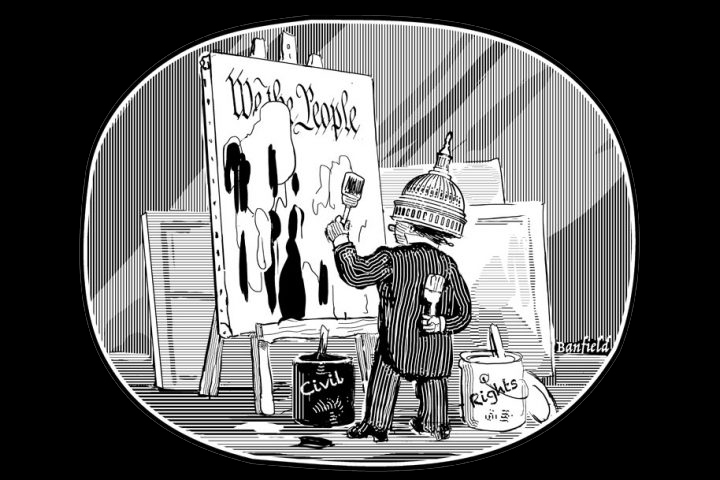
During a democratic town hall event hosted by the Human Rights Campaign and CNN on October 10, 2019, then-candidate Beto O’Rourke proposed revoking the tax-exempt status of churches and religious organizations that oppose gay marriage. “There can be no reward, no benefit, no tax break,” he intoned, “for anyone, or any institution, any organization in America, that denies the full human rights and the full civil rights of every single one of us.” O’Rourke’s abuse of the term “civil rights”—his pandering attempt to borrow the moral grandeur of 1964 in order to abrogate the First Amendment—is no longer an anomaly. On the contrary, as Christopher Caldwell so ably shows in The Age of Entitlement, his remark is a perfect example of what civil rights has come to mean.
One of the most astute observers of contemporary politics, Caldwell argues that the United States now has two constitutions. The first is the one on the books. The second arose in the 1960s and replaced the old liberties with new, incompatible ones based on group identities. “Much of what we have called ‘polarization’ or ‘incivility’ in recent years is something more grave,” he writes. “[I]t is the disagreement over which of the two constitutions shall prevail.” More bracing still, he puts the blame for this crisis on the most sacred totem in American politics: our civil rights legislation.
* * *
Caldwell, for many years a columnist for the Financial Times and senior editor of the Weekly Standard and now a contributing editor of the CRB, is no stranger to untouchable subjects. His previous book, Reflections on the Revolution in Europe (2009), was about the wave of immigrants from the Third World that was roiling the continent even in those days before the refugee crisis. It was a prescient book, especially its prediction that ordinary Europeans would not tolerate forever the thicket of euphemisms and taboos that made “an advanced degree in sociology,” as he put it, “a prerequisite for expressing the slightest worry about the way one’s country is going.” Caldwell was able to cut through that thicket partly because he is erudite—with a dry wit and an eye for the telling detail—but it also helped that he was an outsider. Now he is turning on his own country’s taboos, and the courage behind his frankness is commensurately greater.
There were times in the history of Ireland, during the agitations of the 19th century, when it was impossible to get a jury conviction against any nationalist even for cold-blooded murder, because Irish jurors either sympathized with the cause or else feared that anyone who voted to convict would be killed next. Britain therefore had to make certain crimes subject to trial by magistrate, using state-of-emergency laws known as the Coercion Acts, renewed annually by Parliament.
Imagine if, instead of passing annual Coercion Acts, Parliament had permanently abolished the right to trial by jury, not just for political crimes but for every crime and not just in Ireland but in the whole United Kingdom. This is akin to what Congress did when it passed the Civil Rights Act of 1964.
* * *
“Just as assuming that two parallel lines can meet overturns the whole of Euclidean geometry, eliminating freedom of association from the U.S. Constitution changed everything,” Caldwell writes. The Civil Rights Act passed under President Lyndon Johnson was meant to address an emergency situation that most Americans, even most white Americans, recognized as a national disgrace. Over the following decades, those emergency measures would be revealed as a permanent apparatus combining “surveillance by volunteers, litigation by lawyers, and enforcement by bureaucrats.” Civil rights offered “new grounds for overruling and overriding legislatures and voters on any question that could be cast as a matter of discrimination. That was coming to mean all questions.”
If you doubt the infinite adaptability of civil rights to any subject under the sun, consider the multifarious uses to which it has been put. Last year, the University of Missouri-Kansas City took down student art supporting the Hong Kong protests after pro-Beijing Chinese students complained it was discriminatory hate speech. The Second Circuit Court of Appeals ruled that a New York ban on euthanasia violated the civil rights of patients who wanted to be euthanized by treating them differently than “similarly situated” patients who could arrange to die simply by refusing further treatment (the U.S. Supreme Court reversed). There are pavilion-sized homeless encampments on the streets of Los Angeles, employers can hire illegal immigrants with relative impunity, gay marriage is the law of the land—all because of civil rights law, directly or indirectly.
This metastasis was contrary to the explicit assurances of the original sponsors of the 1964 law. Senator Hubert Humphrey famously promised to eat the paper on which the bill was printed if it were found to require anything as ambitious as racial preferences in hiring. He also promised that it would create only “about 400 permanent new Federal jobs.” Within ten years the Justice Department’s Civil Rights Division alone had more than twice that number. “The bill does not permit the Federal Government to interfere with the day-to-day operations of a business,” promised Representative William McCulloch of Ohio, ranking Republican on the House Judiciary Committee. It did not tell a bank “to whom it may or may not make a loan” or a landlord “to whom he must sell, rent, lease, or otherwise use his real estate.”
* * *
Of course, the law—and its 1968 successor—did do all that, and more. One of Caldwell’s most provocative arguments is his rejection of the belief, common among conservatives, that there is a “good” civil rights law buried beneath the quotas and diktats and that “[o]nce the country came to its senses and rejected this optional, radical regime, it could have the good civil rights regime back.” Even in its original incarnation, civil rights law required employers to collect extensive demographic data on their workers, institute grievance procedures and performance reviews, hire human resources directors to enforce the new rules (Caldwell aptly compares them to “twentieth-century commissars”), and—most far-reaching of all—impose strict censorship on what their employees were allowed to say.
“Political correctness,” says Caldwell, is simply “the cultural effect of the basic enforcement powers of civil rights law.” He cites Los Angeles Dodgers general manager Al Campanis, who was fired in 1987 by the team he had worked for since 1943 after an interview in which Ted Koppel asked him about the lack of black executives in major league baseball. Campanis gave a thoughtful answer pointing out that team managers don’t get paid very much and well-known black players might prefer other opportunities. He then got flustered when Koppel called his answer “baloney” and “garbage,” and offered a rambling second answer that ended with him speculating that maybe black men are poor swimmers because “they don’t have the buoyancy.”
Today we attribute outrage storms to social media, but, as Caldwell points out, organizations like the Dodgers don’t cave just because they are afraid of bad publicity. They do it because they’re afraid of lawsuits. Comments like Campanis’s, not actionable in themselves, can serve in an anti-discrimination case as evidence of a hostile work environment or covert bias. The comments need not even be made in the workplace. In a 1987 suit brought by a female English professor, claiming Boston University had wrongly denied her tenure because of her sex, her case partly rested on a speech given years earlier by the university president in which he made standard socially conservative points about working women and child-rearing. The district court ruled that B.U. had indeed acted out of sexism and ordered the school to give the woman tenure, plus $215,000.
* * *
The genius of civil litigation as a method of censorship is that it puts private companies, not government, in charge of enforcement. “[T]he fear of litigation privatized the suppression of disagreement, or even of speculation,” explains Caldwell. “Because there was no statutory ‘smoking gun’ behind it, this new system of censorship was easily mistaken for a change in the public mood.” Conservative brains were scrambled by this new situation in which businesses were the bad guys, so they fell back on the tactic of pointing out horror stories of P.C. overreach, hoping that the sheer ridiculousness of these examples would drive a stake through political correctness. This tactic will never work, Caldwell insists. It doesn’t matter how ridiculous business owners consider the latest P.C. demands. As long as the law requires them to be vigilant about conduct that can be characterized as discriminatory, they are going to keep enforcing P.C. rules.
Organizations are forced to err on the side of political correctness because civil rights law is fundamentally vague, even self-contradictory. Affirmative action at professional schools is defended on the grounds that minority populations are better served if they have doctors and lawyers who look like them. When Walgreens was found to be assigning black managers to stores in certain neighborhoods on the logic that black customers are better served by managers who look like them, the resulting anti-discrimination case cost the company $24 million to settle. When Ann Hopkins sued Price Waterhouse for sex discrimination for not making her a partner, the court found in Hopkins’s favor because the firm had ignored objective criteria, like dollar value of business brought in, in favor of subjective measures like personality. Last year, a judge upheld Harvard’s admissions policy against the lawsuit brought on behalf of rejected Asian applicants because she found that Harvard must be allowed to ignore objective criteria, like test scores, in favor of subjective measures like personality.
Race-conscious, colorblind, subjective, objective—the less consistent the law is, the more power left-wing activists have to define what the rules really are. The result is to keep ordinary citizens in a constant state of nervous deference. Even “speculating, wool-gathering, or talking off the cuff” was now legally risky, Caldwell writes. “Americans in all walks of life began to talk about the smallest things as if they would have their lives destroyed for holding the wrong opinion. And this was a reasonable assumption.”
* * *
If the consequences of civil rights law have been as totalitarian as Caldwell says, why has the harassed majority not revolted? The short answer is that they tried. Caldwell identifies the election of Ronald Reagan in 1980 as the moment when adherents of the old Constitution fought back, and the next eight years as the period when their hopes were conclusively defeated. “Reagan changed the country’s political mood for a while,” he laments, “but left its structures untouched.”
Reagan promised to shrink government, roll back the Great Society, and end affirmative action “with the stroke of a pen.” Instead, the national debt tripled. The federal civil rights bureaucracy proved as impossible to abolish as the Department of Education. Voters favored lowering immigration and getting control of the border, and Reagan promised to do it, but the compromise bill passed in 1986 traded immediate amnesty for enforcement measures that never came. “Reagan flung open the gates to immigration while stirringly proclaiming a determination to slam them shut,” Caldwell observes. “Almost all of Reaganism was like that.”
The voters who might have revolted against this betrayal were, Caldwell argues, essentially bought off. Public and private debt rose dramatically in the 1980s, and much of that borrowed money ended up in the pockets of white Baby Boomers in the form of tax cuts and consumer credit. These were the same people whose status in the political order had been altered for the worse by the civil rights revolution, and this borrowed prosperity allowed them to think that the old and the new constitutions could coexist. “[F]or one deluded generation,” suburban whites were able to recreate “a Potemkin version of the old order.” Their “easy and indulgent lifestyle”—the Age of Entitlement of the book’s title—was all funded by debt, but it was “convincing enough to draw vast numbers of people to construct it, like the pyramids or the medieval cathedrals or the railroads.”
That Boomer lifestyle was also made possible by immigration, which Caldwell argues is another kind of debt. In exchange for cheap labor now, citizens must eventually pay in government services and burdened infrastructure, as well as cultural friction. These debts are conveniently “off-balance-sheet” and can easily be ignored by those whose position in the social order makes immigration seem to them like an unmitigated boon. Demographics complicated the debate by making immigration “what the spread of slavery in the western territories had been before the Civil War—an issue that could be used by one side or the other to connive at a position of permanent political dominance.” It was therefore inevitable that immigration would play a starring role in the 2016 election when partisans of the old Constitution staged their last-ditch effort to elect a president who might succeed where Reagan failed.
* * *
Caldwell ends his book, not by offering any solution, but by summarizing the impasse that had developed by 2016:
Democrats, loyal to the post-1964 constitution, could not acknowledge (or even see) that they owed their ascendancy to a rollback of the basic constitutional freedoms Americans cherished most. Republicans, loyal to the pre-1964 constitution, could not acknowledge (or even see) that the only way back to the free country of their ideals was through the repeal of the civil rights laws.
If the repeal of civil rights law is indeed “the only way back” to the old Constitution, then liberty is doomed because those laws will never be repealed. So what now?
Some conservatives propose adapting civil rights law to their own ends. The lawsuit alleging that Harvard discriminates against Asian applicants is one example of this. Education expert Frederick M. Hess of the American Enterprise Institute has proposed busting the college bubble through a disparate-impact lawsuit seeking to invalidate college degree requirements for jobs where they aren’t strictly necessary, the same way Griggs v. Duke Power Company (1971) invalidated intelligence tests.
While conservatives are coming up with clever lawsuits like Hess’s, the Left has their own ideas for what should come next in the ongoing evolution of civil rights. Professor Ibram X. Kendi of American University, a National Book Award winner and Guggenheim fellow, was invited by Politico magazine to participate in its September/October 2019 symposium feature “99 Ways to Fix American Politics.” He proposed “an anti-racist constitutional amendment” that would “make unconstitutional racial inequity over a certain threshold” and also establish a Department of Anti-racism (DOA) “comprised of formally trained experts on racism.”
The DOA would be responsible for preclearing all local, state and federal public policies to ensure they won’t yield racial inequity, monitor those policies, investigate private racist policies when racial inequity surfaces, and monitor public officials for expressions of racist ideas. The DOA would be empowered with disciplinary tools to wield over and against policymakers and public officials who do not voluntarily change their racist policy and ideas.
This thought bubble appeared too late to be included in Caldwell’s book, but it is a perfect encapsulation of his argument that once you make the elimination of bias your highest goal, there is no violation of liberty you cannot justify.
* * *
Kendi’s proposal, though ambitious, is not too far off the reservation. Ivy League law professors Catharine MacKinnon and Kimberlé Crenshaw recently proposed their own “Equality Amendment” that would write into the Constitution that “[e]quality of rights shall not be denied or abridged” on account of sex, ethnicity, national origin, sexual orientation, or gender identity. Such an amendment—or a Supreme Court decision enacting the same protections, extrapolating them from existing laws—would massively aggravate the political crisis The Age of Entitlement describes. It was a mere six years between the publication of Reflections on the Revolution in Europe and Angela Merkel’s fateful “Wir schaffen das” (“We can do this”), which inaugurated the 2015 refugee crisis and made all of the problems that Caldwell had written about much worse. It would be further confirmation of his percipience, but a disaster for the republic, if this book were to have a similar sequel.
via Claremont Review






AFCz
Quote by Lyndon B Johnson…… “These Negroes, they’re getting pretty uppity these days and that’s a problem for us since they’ve got something now they never had before, the political pull to back up their uppityness. Now we’ve got to do something about this, we’ve got to give them a little something, just enough to quiet them down, not enough to make a difference. For if we don’t move at all, then their allies will line up against us and there’ll be no way of stopping them, we’ll lose the filibuster and there’ll be no way of putting a brake on all sorts of wild legislation. It’ll be Reconstruction all over again. [Said to Senator Richard Russell, Jr. (D-GA) regarding the Civil Rights Act of 1957]”
Rusty
If my memory serves me correctly, Johnson also stated that his 1965 bill “The Great Society” would not just be for the next ten years or so, but will be of great benefit and use to the Democrats for 100 years or so. We are still living with that “nightmare” now…